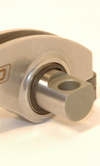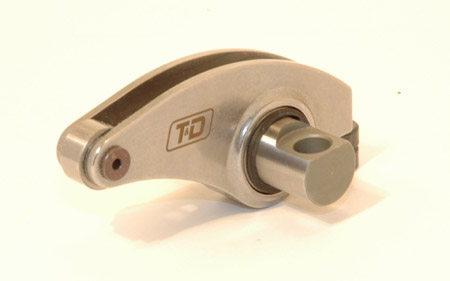Rockers - material choices
 Rockers are a critical element in the valvetrain of any overhead-cam engine, and so we should not be surprised to find that their development continues to be the subject of much activity in racing circles. Much of the racing in the US, for example - including the incredibly popular NASCAR categories and their various 'feeder' series - is based on engines using the overhead-cam (pushrod) valvetrain.
Rockers are a critical element in the valvetrain of any overhead-cam engine, and so we should not be surprised to find that their development continues to be the subject of much activity in racing circles. Much of the racing in the US, for example - including the incredibly popular NASCAR categories and their various 'feeder' series - is based on engines using the overhead-cam (pushrod) valvetrain.
In recent years, NASCAR has allowed the various competitors in its Sprint Cup race series to design a bespoke engine, albeit based on the traditional pushrod valvetrain and with certain dimensional constraints such as in bore spacing, camshaft height and lifter diameter. This was done after deciding to allow Toyota to enter the fray with a bespoke engine, as it had no pushrod V8 in its production vehicle range on which to base a NASCAR engine.
However, if we look a little further back, every competitor's engine was based on a production pushrod V8, all of which would have been equipped originally with steel rockers. Steel is a material for which manufacturing methods are well understood and which is available in good quality at the right price. While the road engines carried on with steel rockers, race engineers looked to lighten the rockers and eventually made the leap to aluminium materials. Aluminium is much less dense than steel, and is therefore a very attractive metal from which to make parts that need to be moved back and forth rapidly. It remains a popular material for many race rockers.
NASCAR, however, is a 'big-bucks' enterprise, with huge crowds at the races and many millions more watching on TV. Naturally there is superb and evenly matched competition between engine manufacturers competing for an advantage and striving to put their cars in the winners circle.
In terms of rockers, what constitutes a good direction for development? Well, according to senior engineers at the top engine manufacturers, stiffness and low inertia are two of the primary goals.

Stiffness is critical to the success of the high-speed operation of the valvetrain. As the regulations effectively limit the engine speed by use of the 'gear rule', the development focus of the engine suppliers is to improve the breathing of the engine to liberate more power. As such, cam-profile development naturally works towards more aggressive valve-lift profiles, lifting the valve more quickly, holding it open for longer and slamming it shut more rapidly, thereby maximising the area under the valve-lift curve. Clearly this must be done within sensible constraints, but it remains the case that, owing to the high acceleration rates expected of the valve without losing control, stiffness is at a premium. Compared to steel, aluminium does not score well where space is limited.
In recent years, the balance has tipped again toward the use of steel as a material for NASCAR rockers. It offers a stiff structure, along with the possibility to remove the traditional pushrod-side adjuster screw. Even without any form of adjustment, aluminium would not survive the stress placed on it by the pushrod contact and so would require a steel insert. By designing the steel rocker with both stiffness and low mass in mind, it has now become the material of choice once more for the most highly developed race rockers.
Fig. 1 - This steel rocker is typical of those enjoying success in NASCAR's top Sprint Cup division (Courtesy of T&D Machine Products)
Written by Wayne Ward